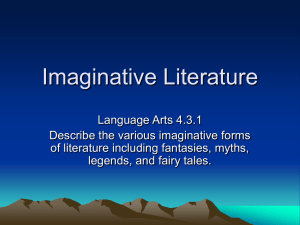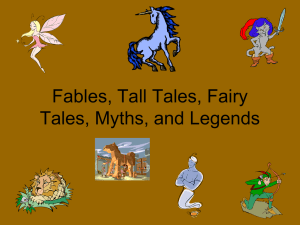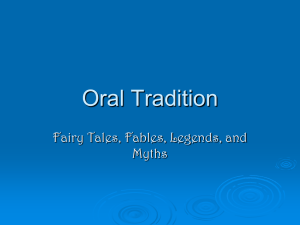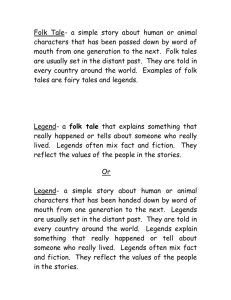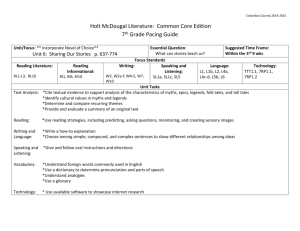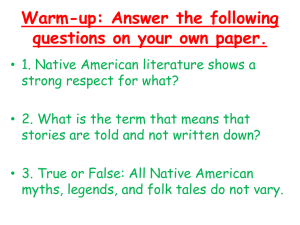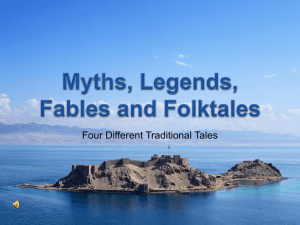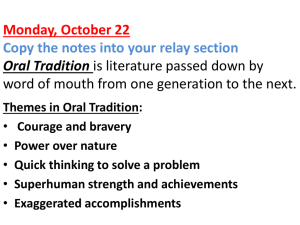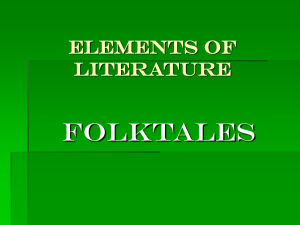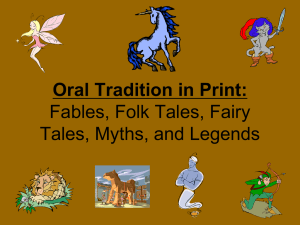Examples of Folk Tales
advertisement
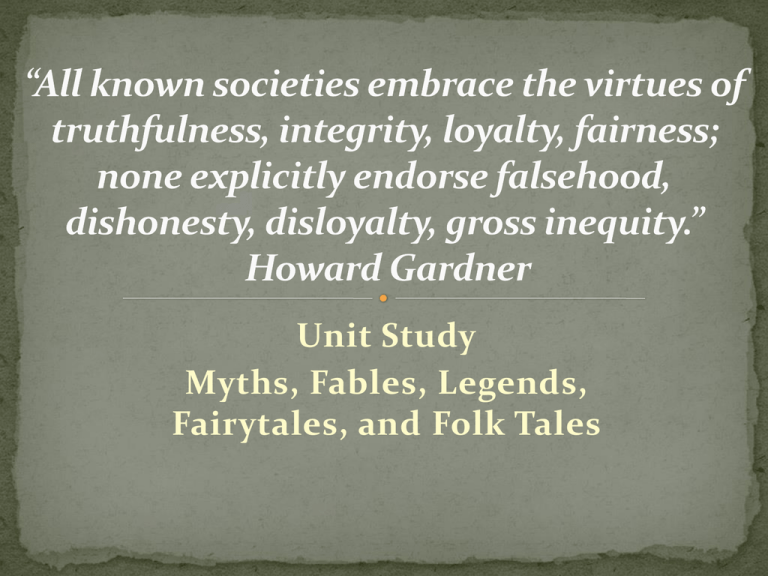
Unit Study Myths, Fables, Legends, Fairytales, and Folk Tales Oral tradition exists in all cultures! Pre-literate times. Stories have been passed down from one generation to the next. The goal of such story telling is to impart a lesson or moral, and convey to the listeners social codes of conduct. Additionally, these stories preserve cultural identity. “Rule of Three” Part of the story is repeated three times, with minor variations. The first two instances build tension, and the third releases it by incorporating a twist. The stock formula of the first, second, and third attempts makes the story easier to remember. Storytellers traditionally hold a high place of honor in his society. The duties of an oral storyteller includes: advisor, court singer, poet, tribal historian, genealogist, teacher, composer, critic, warrior, traveler, and reporter. Nicknames: Griots—West Africa Bards—Gaelic Ashiks—Arabic Scops—Anglo-Saxon Brahmans—Hindu Elements of Myths Examples of Myths Ancient stories dealing with supernatural beings, heroes, ancestors, or gods Attempts to explain mysteries, supernatural events, and cultural traditions Events are symbolic not intended to be factual Themes: Origin stories, lessons about moral behavior and social values. Noah’s Arc & flood myths 12 Labors of Hercules Achilles' Heel Odysseus and Cyclops Oedipus Rex Creation myths Pandora’s Box Prometheus’ Fire In class reading: Sacred Texts “Rig Veda”, Navajo creation myth, “Tao Te Ching” Elements of Fables Examples of Fables Short and simple, belongs to the Aesop “Tortoise and the Hare” oral tradition of story telling. Protagonist is sometimes an anthropomorphized animal— has human traits and abilities Story is pure fiction but still conveys a moral or lesson Poetic elements include double meaning, and symbolism—the animals reflect human nature A person who writes fables is a fabulist Beatrix Potter “Peter Rabbit” David Sedaris “Squirrel Seeks Chipmunk” Doctor Seuss George Orwell’s Animal Farm In class reading: The Dog and the Wolf Amoral figure, does not see right from wrong. Trickster’s key skill is wit and cunning. Sometime the trickster himself is tricked but will still find a way to teach his opponent a lesson. Trickster possesses a balance of opposite traits Omniscient creator and innocent fool Malicious destroyer and childish prankster Physical underdog but clever and savvy Trickster figures include: Br'er Rabbit - of African American origin. Coyote- of native North America. In class reading: “Anansi’s fishing expedition” Elements of Legends Oral tradition, passed down through word of mouth Historical basis, includes some verifiable evidence or facts Exaggerates elements of a real hero or amalgamation of heroes Focuses on the cultural values of a specific people, explains why they believe and act as they do Examples of Legends Lost city of Atlantis William Tell shooting the apple with an arrow Robin Hood St. Patrick and St. Valentine In class reading selections Epic Heroes: Beowulf, Ramayana Legend of the Holy Grail Chivalric Heroes: King Arthur and the Knights of the Round Table Elements of Fairy Tales Pure fiction, fantasy and make believe Doesn’t have to include fairies, but has elements of magic, enchantment, transformation and supernatural beings Theme: good versus evil Once upon a time… happily ever after Examples of Fairy Tales “Rapunzel” “Snow White” Brother’s Grimm Hans Christian Andersen L. Frank Baum Wizard of Oz In class reading selections “Cinderella” Elements of Folk Tales Examples of Folk Tales A story for or about a specific Gravity Hill in Bedford PA group of people/town or country Historical basis, includes some verifiable facts but is exaggerated Doesn’t have to teach a lesson or moral, the theme can show pride for a particular place or culture Any belief or story passed on traditionally, especially one considered to be false or based on superstition Urban Legends Big Foot Johnny Appleseed Paul Bunyan St. Niklaus In class reading selections “La Llorona: The Weeping Woman” The chief purpose of a myth is to explain The chief purpose of a fable is to instruct The chief purpose of a legend is to record important events The chief purpose of fairy tales and folk tales is to entertain the audience
